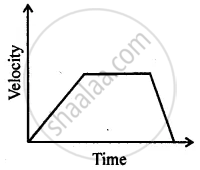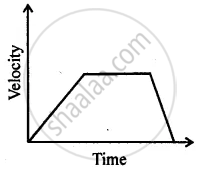Advertisements
Advertisements
प्रश्न
Can you suggest a real-life example about the motion of a body from the following velocity – time graph?

उत्तर
Suppose a train starts from rest and accelerates uniformly for some time and then moves with a constant velocity for a certain time interval. Then on applying the brakes, the train is uniformly retarded and comes to rest after some time in this situation, velocity – time graph of the train will be the same as shown in the figure.

APPEARS IN
संबंधित प्रश्न
A train travelling at 20 m s-1 accelerates at 0.5 m s-2 for 30 s. How far will it travel in this time ?
A car is travelling along the road at 8 ms-1. It accelerates at 1 ms-2 for a distance of 18 m. How fast is it then travelling ?
Differentiate between uniform acceleration and variable acceleration.
A bicycle initially moving with a velocity 5.0 m s-1 accelerates for 5 s at a rate of 2 m s-2. What will be its final velocity?
Write three equations of uniformly accelerated motion relating the initial velocity (u), final velocity (v), time (t), acceleration (a) and displacement (S).
A body, initially at rest, starts moving with a constant acceleration 2 m s-2. Calculate: (i) the velocity acquired and (ii) the distance travelled in 5 s.
Multiple choice Question. Select the correct option.
A body dropped from the top of a tower reaches the ground in 4s. Height of the tower is
How can you find the following?
Velocity from acceleration – time graph.
A stone thrown vertically upwards takes 3 s to attain maximum height. Calculate
- initial velocity of the stone
- maximum height attained by the stone. (Take g = 9.8 ms−2)
Area under a v – t graph represents a physical quantity which has the unit
